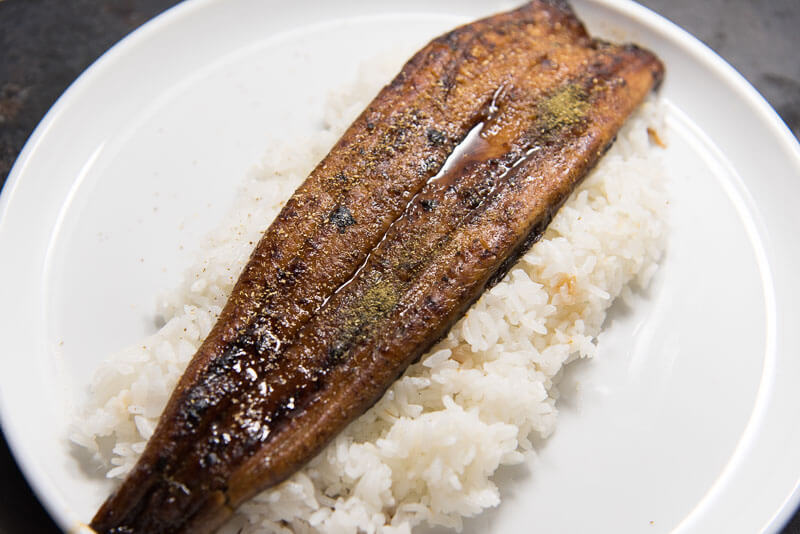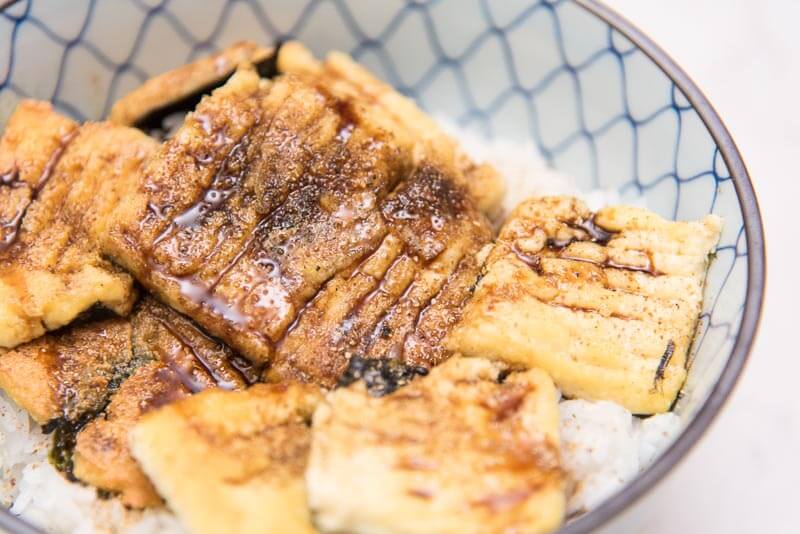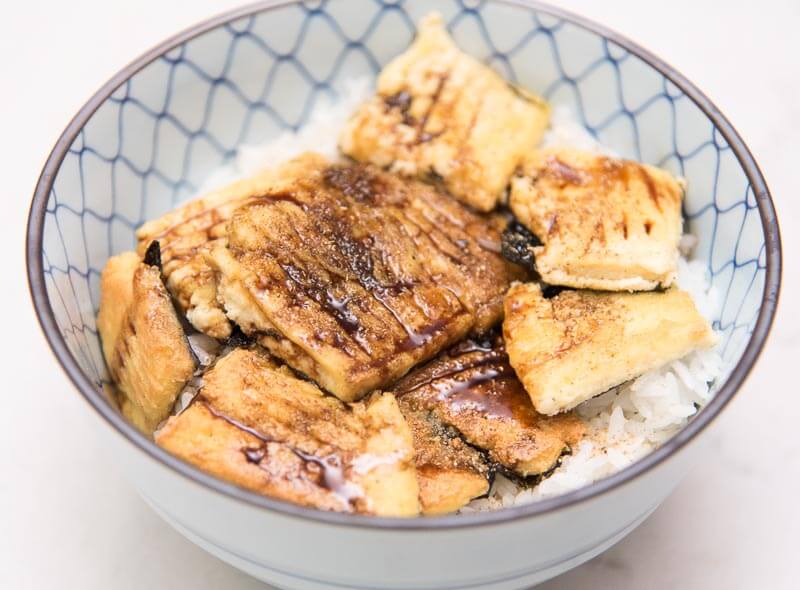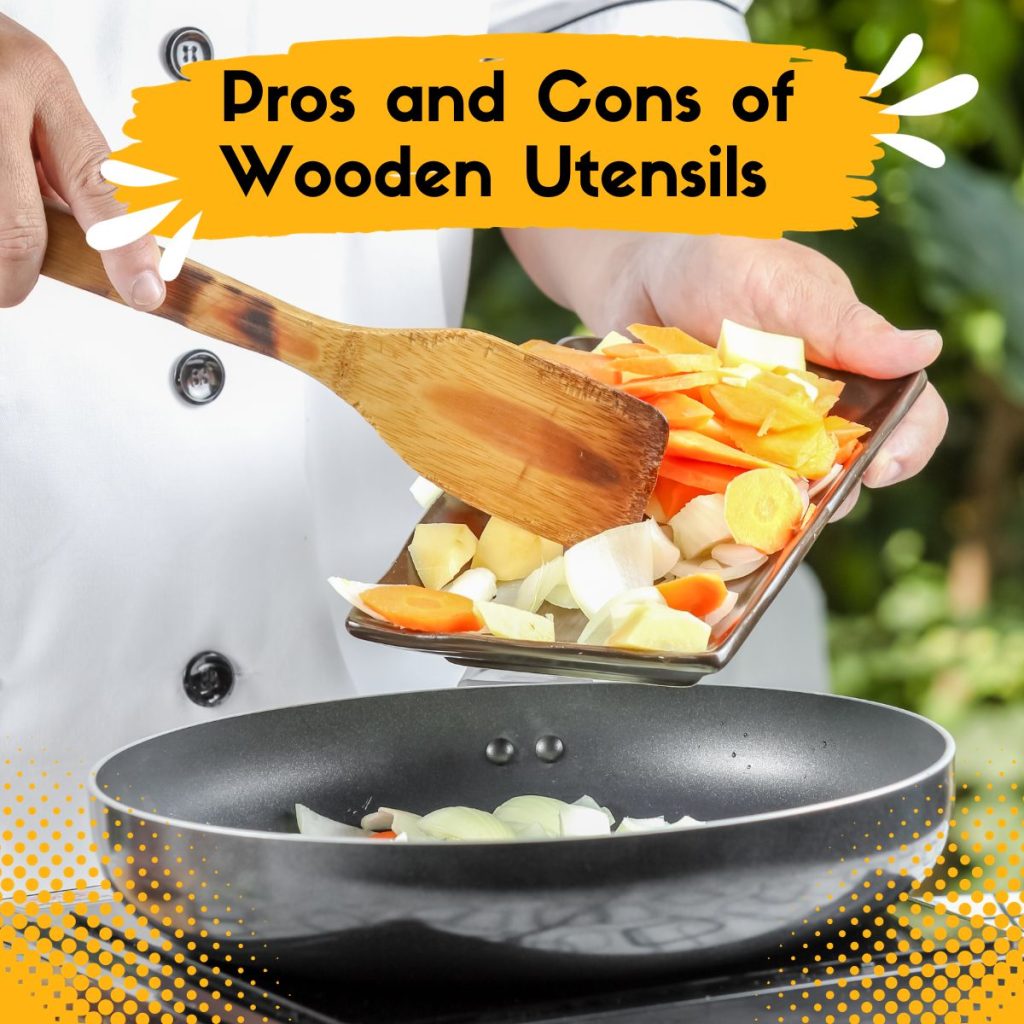Today we’re making tofu kabayaki. This tofu is a tasty alternative to the traditional unagi (eel) kabayaki. I’ll save the superlatives, but I can assure you that this will have you full and enjoying the full essence of the kabayaki experience in no time. Just as you would with regular kabayaki, you can add a bit of sansho pepper for a little kick. This is a simple preparation that may satiate and even impress the most experienced tofu eaters of the universe. Will you be one of them?

What is kabayaki? (蒲焼)
Kabayaki is a method of seasoning and cooking fish, one of the more common being unagi (鰻) or eel. Yes, eel is a fish.
Let’s talk first about unagi kabayaki since that’s what you’re likely to have eaten or will eat while visiting Japan.
There’s several theories on how the dish got it’s name and two includeー
- that the unagi looks like a cattail (after the unagi is cooked on a stick or kushiー串).
- and another is that it looks like the bark of a birch tree after being cooked.
I could see how those theories came to be as the unagi turns a rich dark brown after being cooked with the sauce.
Can you?
Can’t see it? Try squinting next time you see it 😉
For preparation, there are two main styles of making unagi kabayaki, one is Kanto (関東) style and the other is Kansai (関西) style.
- Kanto style the eel is cooked twice- first without seasoning and to allow some of the fat to drip off, and then again seasoned.
- Kansai style the eel is cut down the belly and is only grilled once, preserving all of the fat and flavor from it.
I think they both have their good points and personally don’t prefer one over the other. Some may feel differently, as they do with okonomiyaki or sukiyaki, which also have regional variations!
Since we’re using tofu for today’s dish, we won’t be using either technique.
But thought you might want to know for future unagi eating experiences 🙂

Kabayaki tare (たれ)
For seasoning, the kabayaki sauce or tare in Japanese, can be made with soy sauce, mirin, sugar, sake or various combinations and ratios.
Many of the sauces used by restaurants are secret and have been passed down through multiple generations.
The resulting flavor of the sauce is mostly savory with lots of umami and a slight hint of sweetness.
The tare we’re making today will just use soy sauce, mirin, sake, and a little sugar.
You can try omitting the sugar if you don’t like things sweet or try omitting the sake or adjust the ratios.
Each modification results in a slightly different flavor. Duhh!!
Also, depending on the method of preparation, unagi may be dipped in the tare, which adds not only complexity, but a rich flavor of unagi as well.
So, unless you’re going through lots and lots of unagi, that could be one limitation you (we) face when making unagi at home.
Bummer I know!!
Again, as we’re using tofu not possible, but something worth mentioning.
Not sure I’d want tofu drippings (or tofu water) in my tare!!

The picture above is real unagi I had my dad bring back from Japan on one of his trips. If you get it at the market, it usually includes all you need – the tare or sauce, and a little packet of sansho pepper. All you need is white rice and side of soup!
Unagi vs Tofu
During the Edo period, unagi was something eaten by blue-collared workers.
However, eel these days can get quite expensive.
In part, because the demand exceeds supply.
Even at the market, one piece like the one above can cost 2500 yen ($25) and up.
The good thing is I usually split the large piece, but if I was really hungry I could probably eat it all up!
So in order to not contribute to the eel shortage we’re gonna make this tasty tofu alternative.
No, it’s not the same, but it comes pretty close!
And hey, it’s not mystery meat (fish), it’s tofu!
Save an eel and eat a tofu block 🙂

Making the Tofu Kabayaki
In order to make the tofu patties stick together, you can use various ingredients.
For example, I’ve used egg, pork with panko, fishcake with starch and they all have slightly different flavor characteristics.
For today’s recipe, we’re using a little bit of katakuriko (potato starch) and Japanese mountain yam, also known as yamaimo or nagaimo.
If you’ve never had yamaimo or nagaimo before, it’s probably one of the most sticky slimy things you could possibly eat.
I haven’t found anything more sticky and slimy than it.
It’s sticky and slimy in a good way!
It goes great on rice, or on top of soba, or udon and can also be cooked in a variety of different ways.
It works for the kabayaki because it really doesn’t have much flavor on it’s own.
Which is what we want!
In order to keep this as healthy as possible, I’m using extra virgin olive oil (like I do for everything) to lightly fry the patties.
But if you want a more neutral flavor or don’t like olive oil, just use canola.
Tips for the Tofu Kabayaki
- **Use firm tofu** and if you aren’t going to boil the water out of it, you can do it the more messy way (IMHO) and set a weight on top of it and let the water get squeezed out. This means you have to use a shallow bowl and place something heavy like 5+lbs on top of it. Or alternatively use something like the TofuXpress.
- Thoroughly process the tofu with the starch, yamaimo and salt. This is what’ll bind everything together!
- If your kabayaki tare gets too thick you can thin it by adding a little water
- Add sansho pepper (山椒) Sansho pepper is a pungent and fragrant little spice and packs a punch. If you’ve never had it before, I recommend trying it. It’s not so much spicy, but rather aromatic and herbaceous. There’s nothing quite like it and you can use it for many other things aside from unagi. If you can’t find it at your local store, they sell it here.
- If you want to add another layer of flavor, you could add a tsp or two sesame oil to your cooking oil!

Here’s the live replay – Tofu Kabayaki | Savory Tofu Patties with Yamaimo 🍚
Let me know what you guys think! Have you made anything like this before?
PrintTofu Kabayaki | Savory Tofu Patties with Yamaimo
Today we’re making tofu kabayaki. This tofu is a tasty alternative to the traditional unagi (eel) kabayaki. I’ll save the superlatives, but I can assure you that this will have you full and enjoying the full essence of the kabayaki experience in no time. Just as you would with regular kabayaki, you can add a bit of sansho pepper for a little kick. This is a simple preparation that may satiate and even impress the most experienced tofu eaters of the universe.
- Prep Time: 15 minutes
- Cook Time: 5 minutes
- Total Time: 20 minutes
- Yield: 4 people 1x
- Category: Main Dish
Ingredients
for the kabayaki tare (sauce)
- 1/4 cup sake
- 2 Tbsp mirin
- 2 Tbsp soy sauce
- 1/2 Tbsp sugar
for the tofu kabayaki
- 16 oz block firm Tofu (450 grams)
- 1/4 cup yamaimo grated (60-70 grams)
- 2 sheets nori (dried seaweed)
- dash salt (or soy sauce)
- 1 tablespoon katakuriko (potato starch, alternatively corn starch )
- extra-virgin olive oil (for frying and or sesame oil (optional))
Instructions
For the kabayaki tare
- First measure out all ingredients for the sauce and combine in a sauce pan.
- On medium heat bring to a simmer and allow to reduce, until it gets slightly thick 7-10 min. If you want it thicker or more concentrated cook 3-5 minutes longer, but watch closely.
- While the sauce is cooking, prepare the other ingredients.
For the tofu kabayaki
- In a medium sauce pan, boil water and add the tofu broken into small pieces. Boil for 4-5 minutes to remove the water.
- Peel and grate the yamaimo and add to a food processor along with cornstarch and a dash of salt.
- After the tofu has cooked for about 5 minutes, drain and allow to cool. You can run cold water over it to expedite.
- Once cooled, add tofu to food processor and blend until thoroughly combined.
- Lay out a piece of nori and use an oil coated spatula to spread the tofu mixture over in a 1/4-1/2in thick layer.
- Heat olive oil in a large saute pan and once it starts shimmering, add in tofu pieces nori side up and allow to cook 2-3 minutes, until slightly browned.
- Use a slotted spoon to remove from the oil.
- Serve over warm white rice and drizzle/brush the sauce over with a few sprinkles of sansho pepper.
Notes
Optional: for additional texture, sprinkle katakuriko on both sides of the tofu nori sheets before frying








Konnichiwa! (Hello!) I'm Pat Tokuyama, a Japanese tofu cookbook author, who travels for music, food, and adventure. If you like Japanese tea, checkout some of the newestorganic japanese tea, matcha bowls and noren and more!
** Curious about the Plant Based Japanese Cooking Club? ** Learn more here!